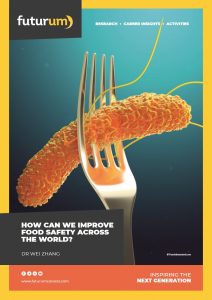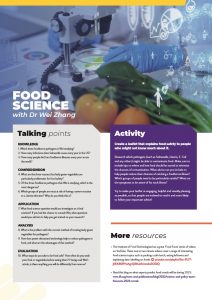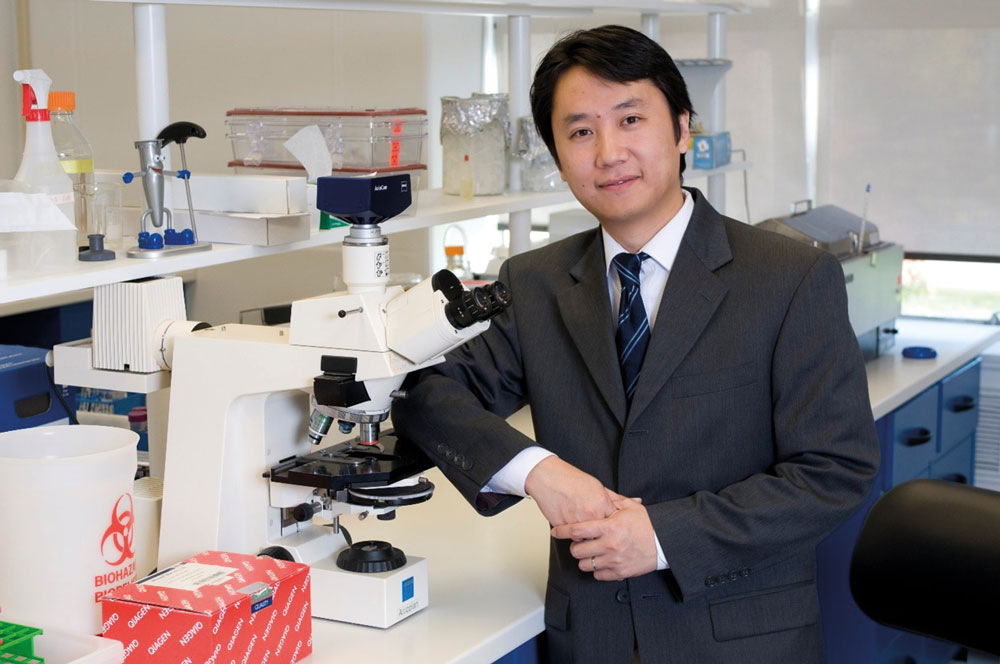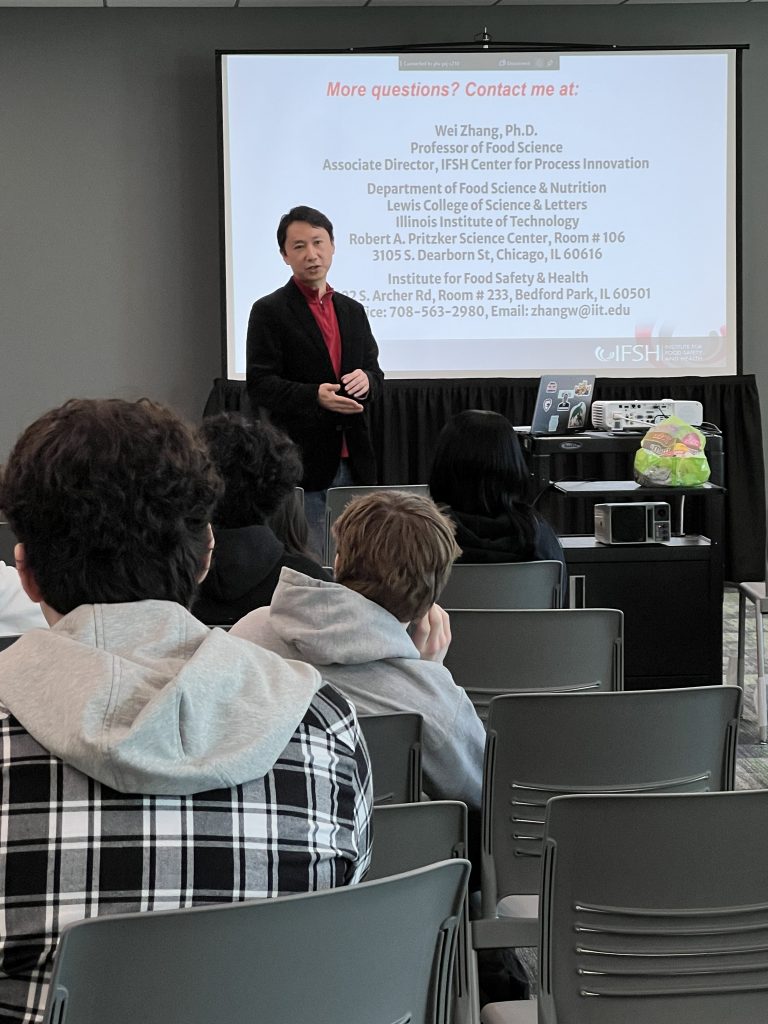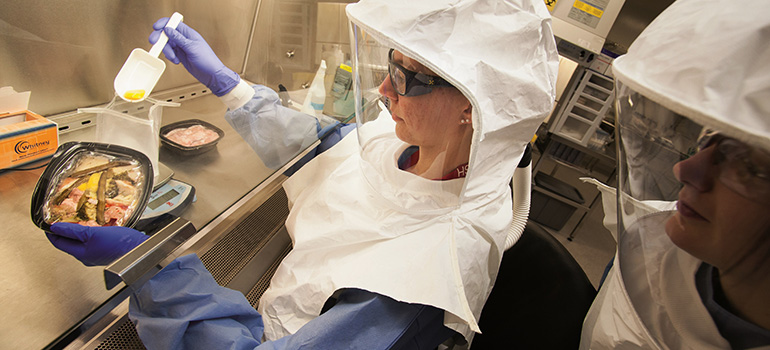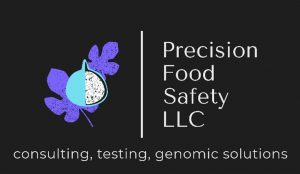How can we improve food safety across the world?
Around 600 million people – which is almost 1 in 10 people worldwide – become ill every year from a foodborne illness. 420,000 of those people die. At the Illinois Institute of Technology in Chicago, USA, Dr Wei Zhang, a professor of food science, is focusing on improving food safety for everyone.
TALK LIKE A FOOD SCIENTIST
Escherichia coli (E. Coli) — a bacterium that normally lives in the intestines. E. coli is usually harmless, but some strains can cause diarrhoea
Desiccation — the process of drying out
Genome — all the genetic information of an organism
Listeria — a group of bacteria, one type of which can cause life-threatening illness
Motility — the ability of plants, organisms and very small forms of life to move
Pathogen — an organism that causes disease, such as a bacterium, virus, fungus or parasite
RNA sequencing — a laboratory technique used to learn the exact sequence of how RNA, a type of nucleic acid, is synthesised in a cell
Salmonella — a common bacterium that makes people ill
Virulence — the harmfulness and danger of a disease
The food we eat fuels our lives! However, there are hundreds of different types of viruses, bacteria, fungi and parasites which can survive in food and make our food dangerous for us instead. At the Illinois Institute of Technology, Dr Wei Zhang is studying three of these foodborne bacterial pathogens: Salmonella, Listeria and E. coli. These pathogens range in virulence depending on who catches them and what strain – or serotype – is caught.
What are Salmonella, Listeria and E. coli?
Salmonella is a very common bacterium that can cause diarrhoea, stomach pains and fever. “The specific serotype of Salmonella called non-typhoidal Salmonella is ranked number one in the category of bacterial pathogens and causes about 1.35 million infections, 26,500 hospitalisations, and 420 deaths in the US every year,” says Wei. Escherichia coli (also known as E. coli) is a bacterium that normally lives in the intestines of healthy people and animals. Most serotypes of E. coli are harmless and unnoticeable, but a few serotypes, such as E. coli O157:H7, can cause severe stomach cramps, diarrhoea, vomiting and even kidney failure. “This serotype causes about 265,000 infections per year in the US,” says Wei.
In comparison, a Listeria infection is much less common but can be much more dangerous. “Only about 2,500 cases are reported per year in the US,” says Wei. However, one in five people with a Listeria infection will die from it. It is fatal for newborn babies, pregnant women, people older than 65 and people with weakened immune systems.
How do these pathogens survive?
“Bacterial pathogens such as Salmonella, E. coli O157:H7 and Listeria are highly adaptive,” says Wei. As well as being able to sense what is around them and search for nutrients, these bacteria can establish colonies through biofilm formation – a process whereby they attach and grow on a surface in a moist environment. The pathogens also have techniques that allow them to survive in cold temperatures – such as in refrigerators – and in dry spaces that lack water.
“They can even change their body shapes, called cell morphology in scientific terms, to counteract starvation and resist stresses like desiccation,” Wei adds. These abilities make it challenging for food producers to eliminate these pathogens in food production lines. Salmonella, which lives most comfortably inside the gastrointestinal track of warm-blooded animals, has also developed special skills that allow it to survive outside of its host. “Our studies suggested that when Salmonella enters a low-moisture food such as peanut butter, it can shrink in size, reduce metabolism, and become hundred times more heat-resistant than its counterpart in an animal host,” says Wei. This means that the usual heat treatments that food producers use to make food safe may not be enough to ensure the Salmonella pathogen is not in the final food product.
Which food groups has Wei been researching for foodborne pathogens?
One area that Wei has been looking at for foodborne pathogens is fruit and nut surfaces. “These surfaces, although not ideal for Salmonella to thrive, have been frequently linked to foodborne outbreaks of salmonellosis,” says Wei.
“The genome of Salmonella contains more than 4,000 protein-coding genes, many of which play roles in bacterial stress resistance, motility, biofilm production and virulence,” he adds. This means that these genes can control how dangerous Salmonella is, how fast it can spread, how easily it can attach to surfaces, and how well it is able to move.
In order to assess how Salmonella was surviving and attaching itself to these different surfaces, Wei looked at 120,000 mutants of a Salmonella strain on almond shells. Alongside his team, he spent two weeks monitoring the survival of these strains within a humidity-controlled chamber. “Our results showed that food surface characteristics, environmental factors, and an unexpectedly complex metabolic and regulatory network in Salmonella contribute to bacterial attachment and survival on different types of food surfaces,” explains Wei.
Wei has also examined leafy vegetables, as Salmonella and E. coli often cause outbreaks related to this food group. Leafy green vegetables are a high priority for food safety and are an especially problematic food group for three reasons. Firstly, they are widely consumed and are a crucial part of a healthy diet. Secondly, leafy vegetables cannot be thermally treated like most other processed foods, as they cannot be heated to high temperatures. This means that there is no step that kills the pathogens inside the leafy greens, and, instead, they are rinsed with chlorinated water. Thirdly, Salmonella and E. coli are very good at contaminating raw vegetables and surviving farming and post-harvest processes, which means that they can remain alive for weeks in leafy green vegetables.
How do we protect these foods from pathogens?
Reference
https://doi.org/10.33424/FUTURUM386
(© Lightspring/shutterstock.com)
Currently, leafy green vegetables are treated to remove pathogens by being washed with chlorinated water. While this is supposed to decontaminate the surfaces of the vegetables, the process is unable to kill all the pathogens. Wei thinks this might be because chlorine can lose its disinfecting ability quite quickly when there are lots of vegetables in the wash tank, and because bacteria are often able to hide in hard-to-reach places and can become resistant to chlorine over time. “For these reasons, chlorinated water wash alone may not be sufficient to reduce the pathogen load to no/low risk levels,” he explains.
Is there a better solution?
Scientists like Wei are looking at how ultrasound technology can be used to help reduce pathogens in food. Power ultrasound is a green technology that is good for the environment and can inactivate dangerous microorganisms on food, while still preserving the food’s quality. Wei has been using advanced RNA sequencing techniques to look at how this technology is able to inactivate certain foodborne pathogens. “We are also trying to optimise the ultrasound frequency and chemical dosage for maximum pathogen inactivation in persistent reservoirs such as wash water,” he says. Power ultrasound has promising effects. So far, Wei’s research suggests that combining chlorinated water wash with power ultrasound technology can reduce the number of bacterial pathogens on the surfaces of fresh produce by more than 10 times.
Where might Wei’s research go next?
“One new research topic that I am interested in is the foodborne pathogen Cronobacter,” says Wei. Cronobacter is a bacterium that can survive in dry food products, such as powdered infant formula, powdered milk and herbal teas, for long periods of time. Cronobacter infections can be deadly for young babies and patients with weakened immune systems. Currently, Wei is developing new research ideas that will allow him to study how Cronobacter is able to survive these dry conditions.
The long-term goal for Wei and his team is to explain how pathogens survive in food-related environments. His work will allow scientists to develop more effective strategies to ensure food is safe and pathogen-free for everyone across the world.
 Dr Wei Zhang
Dr Wei Zhang
Department of Food Science & Nutrition, Illinois Institute of Technology, Chicago, USA
Fields of research: Food Science, Food Safety, Food Microbiology
Research project: Investigating foodborne diseases such as Salmonella, Listeria and E.coli
Funders: US Department of Agriculture (USDA), US Food and Drug Administration (FDA)
About food science
Food scientists strive to ensure there is affordable, healthy and sustainable food for everyone around the globe. Food science is an interdisciplinary field that combines chemistry, biology, physics, engineering, nutrition, mathematics, psychology and other disciplines. Working in this field could lead you to making new gluten-free foods or meat substitutes, investigating ways to extend the shelf life of foods, examining foodborne diseases in a laboratory setting, testing the safety and efficiency of food processes, or looking at what people from different countries and cultures choose to eat and why. “There are unlimited research opportunities in the field of food microbiology for the next generation of food scientists,” says Wei.
Food scientists working in a laboratory use lots of different microbiological, molecular and genetic tools to help them do their work. “These often include cell culturing, optical and electronic microscopy, recombinant DNA technology, gene knockout mutant construction, high-throughput DNA and RNA sequencing, and bioinformatics!” says Wei.
What does a day in the lab look like for a food scientist?
“A typical day in the lab would start with examining the overnight bacterial cultures, inoculating bacteria in food samples and testing different treatment conditions, and end with recording experimental data and conducting statistical analysis,” says Wei.
Pathway from school to food science
• “If you want to work in food science, study STEM subjects in high school and train yourself to be an independent thinker,” says Wei. “Of course, you have to be a food lover to start with!”
• “College-level courses such as biology, microbiology, statistics, chemistry, biochemistry, molecular biology, as well as nutrition and food engineering would be part of the core curriculum for food science majors,” says Wei.
• To work in food science, study an undergraduate degree in food technology, food science or food engineering. If you want to become a researcher, you will need to complete a master’s degree and a PhD afterwards.
• Useful experience for aspiring food scientists includes working in food processing and production. Try to find volunteer opportunities or work-experience in a food environment to make sure you are truly interested in food before embarking on this career.
• Wei recommends learning about The Institute for Food Safety and Health (IFSH), a research association where he is an Associate Director. The IFSH has lots of information about food safety, food processing and nutrition, and you can even have a look through current food science research projects. “We offer several educational programmes to the public, including workshops and presentations at high schools and various food science fairs,” he says.
Explore careers in food science
• The Institute of Food Technologists’ website has a great section about careers in food science, including short videos featuring food scientists talking about why they like their work. The website also includes salary ranges for some of the different jobs within food science.
• “Career opportunities in food science are quite diverse,” says Wei. “You can choose to work in the industry, academia or government in many different roles and capacities such as food technologists, microbiologists, nutritionists, flavour chemists, product developers, sensory specialists, food engineers, laboratory directors, technical advisors, quality assurance managers, food
safety inspectors, legal counsels, and food law attorneys, to name just a few!”
• Wei recommends looking at Phi Tau Sigma – the Honor Society of Food Science and Technology, the International Union of Food Science and Technology and the International Association of Food Protection for advice about working in food science.
• According to PayScale, the average annual salary for a food scientist in the US is around $70,000. Wei says, “You can earn more than $200,000 if you have over 10 years of experience in the field.”
Meet Wei
Who or what inspired you to become a food scientist?
I started learning to cook at an early age. My grandfather was a chef at a high school for my entire childhood. I had the privilege to taste many wonderful dishes he made. During my first year in college, I was choosing between a food science and a biotechnology major. Eventually, I chose food science because of several culinary courses in the core curriculum. Then, I realised that food science was not all about cooking; it is a very broad scientific discipline encompassing microbiology, chemistry, engineering and nutrition.
To what extent does your interest in food extend beyond work?
Most of the time, I do my own cooking at home. I also enjoy eating at a good restaurant from time to time. Food safety is always on my mind when I prepare foods for my family and my pets. On numerous occasions, I have been asked for tips regarding food safety by friends, colleagues and industry professionals, as well as the public/social media. I have been asked questions about food package swelling, extending shelf-life for soy products, pathogens in infant formula, peanut allergen in chocolate, and the safe use of raw food ingredients in home recipes. There are lots of topics people want to know about!
What motivated you to set up your own company? What challenges and rewards does it offer?
The motivation came from two colleagues of mine, plus an increasing number of requests sent to me for technical consultation in recent years. In 2022, I founded Precision Food Safety, LLC, a Chicago-based company that provides expert consulting, rapid testing and reliable genomic solutions to satisfy the food safety needs of consumers, food manufacturers, and legal and regulatory agencies. Unlike traditional food safety testing companies, we specialise in using advanced genomic technologies to solve food safety problems. We also provide scientific reviews on food production processes and expert witness testimonies in legal investigations. Like any other new small business, the challenge is to reach new clients. The reward is a strong sense of accomplishment and pride that I can use my technical knowledge to solve practical problems in food safety.
What are your proudest career achievements so far?
Some of my career achievements have included editing and publishing a book about foodborne bacterial pathogens, receiving five highly competitive US Department of Agriculture (USDA) research grants, and being invited to review grant applications for the National Science Foundation (NSF), the National Aeronautics and Space Administration (NASA), and the European Transnational Funding and Research Initiative of the European Union (EU). However, my proudest achievements are my students, who worked with me for their master’s or doctoral degrees and now all have their own very successful career paths. Some are tenured professors at top-tier research universities; some are senior scientists in governmental agencies; some are food safety managers in large companies; and some are pursuing more advanced training at universities such as Cornell University and the Massachusetts Institute of Technology.
What are your ambitions for the future?
I have personally trained about 30 students and scientists in the field of food safety microbiology in the past 17 years at Illinois Tech. My goal is to educate and train 100 more students before I retire. This is a huge task, but I still have about 20 to 25 years to go!
Wei’s top tips
1. Always think outside of the box.
2. Pay attention to trivial details.
3. Form a habit of experimenting with new ideas.
Do you have a question for Wei?
Write it in the comments box below and Wei will get back to you. (Remember, researchers are very busy people, so you may have to wait a few days.)

